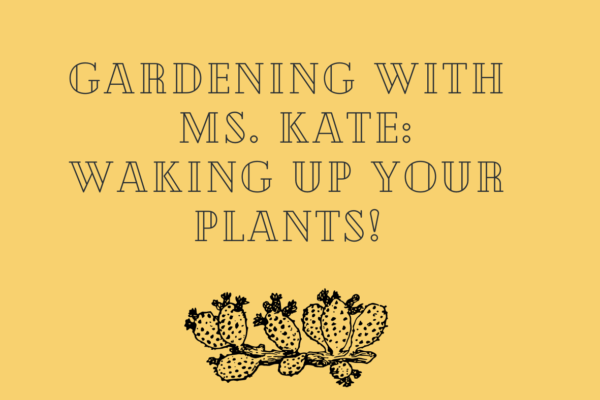
Hello! My name is Ms. Kate, and welcome to my gardening series, Gardening with Ms. Kate, where we learn new tips and tricks to help our plants grow. For this edition, I am going to reference a past post regarding dormancy. As a refresher, dormancy is the period a plant goes through in the Winter, where growth slows down to reserve energy due to less light. Now that we are in Spring, our plants are coming out of dormancy, but they still need a little boost. As we all know, it can take a lot of energy to get out of bed, even if you have had a good deal of rest. Below, I am going to list what to do to refresh your plants and have them start their new growing season with their best root – I mean, FOOT forward.
Check Roots/Repot
I combined checking roots and repotting into the same section since they are very connected. In preparing your plants for Spring, it is important to check your plant for root rot as well as to see if it is rootbound. Root rot is evident if the roots are not white but brown and thin. Rootbound is exactly that when your roots are twisted and tangled into each other. This is caused when your plants’ roots run out of room to grow, so they have to recycle the allotted space and grow over the pre-existing roots. A quick sign of a rootbound plant is seeing if you have any roots peeking from the pot’s drainage hole. With Spring being the beginning of the growing season, this is the perfect time to give your plants a fresh restart.
The soil you can use for different plants:
- Well-draining soil, like cactus mixes, is perfect for succulents, philodendrons, Scindapsus, pothos, ZZ, and snake plants because of how porous it is. Porous just means that the water drains and does not sit on the roots, causing rot. You can also mix in perlite to your soil for extra porous-ness, or you can add rocks at the bottom of your pot that can also help prevent root rot. Another trick to keep the soil aerated is to take a pencil to break up the soil once a month.
- African violets, anything calathea, and Syngonium all enjoy moist soil. You do not have to worry about porous soil for these plants, so ignore the cactus mixes we stated for the porous-loving plants. You can add peat moss or coconut coir/fiber to retain moisture for a little longer for these plants. If they do not have enough moisture, they “faint.” Oh yes, plants can faint, and they will when they haven’t been given enough water (for these types, not cacti or other arid plants). Just take a moment to monitor your plants, check the soil, and if you are skeptical of watering (root rot can still happen, even if they do love water,) give yourself a day, then water.
Prune
Just like how we need to cut our hair for it to grow healthy, we need to cut back our plants. This helps promote the plant to grow, as well as conserve energy. Plus, you can propagate the cuttings! Win, win!
Fertilize
Our plants have lost energy in the Fall and Winter and will need a boost for the growing season.
There are numerous types of fertilizer. Some can dissolve in water, and some come in stakes that will slowly release in the soil. Just find the one that is best for you and make sure to use caution when applying fertilizer, and follow the guidelines so that you don’t accidentally burn your plant with too much fertilizer.
Protect
Protect them from pests by using a few tricks to ward any unwanted creatures away!
You can buy glue traps for fungus gnats. They are especially attracted to any that are bright yellow. To avoid mites or other pests without using strong or harmful pesticides, try hydrogen peroxide! In a spray bottle, I do one part 3% hydrogen peroxide, and two parts water. I mist the leaves, and if I have a run-in with any pests directly, I focus on the soil.
Are you a student? You can also put those pencil shavings to good use as well by placing them on your topsoil. I did not know this, but pencils are made from cedar wood, and pests cannot stand it, especially if shavings are on damp soil. How cool is that?
Here are some clues to identify pests: fungus gnats are just little flies that hover around your plants. They adore moist soil, a foundation for the next generation of gnats. The hydrogen peroxide mix recipe will help stop eggs in the soil from hatching. The glue traps will help reduce them in their tracks, especially if the trap is yellow. For some reason, bright yellow really attracts their magnifying eyes!
Spider mites are sneaky, you will never see them before they strike. But, you will notice that they are vacating your plant by the web they leave behind in the alcoves of the victims’ stems. To get rid of these nuisances, wash your leaves by placing them in a shower or wiping them down and then spraying them with the hydrogen peroxide mixture.
Scales look exactly like it…silvery scales. They enjoy sapping the life out of your plant and will do it quickly. To get rid of these, dab the insects with a paper towel that has been dipped in hydrogen peroxide or shower your plant.
When battling pests, the key is consistency. Take a moment to look over your plants to see if there are any signs of visitors on their leaves or stems, and if you have to go to war, spray over your plant with the peroxide mix every other week. It can be frustrating battling with these stubborn pests, but you’ve got it, and if your plant is too far gone, that is totally fine too. I have lost many plants from insects, so don’t let it bug you! (Get it?)
There you grow-go! You are now ready to spring into action for this growing season. You’ve got this!
To learn more information about plant care, check out these books that helped me out a lot in the past: Click here.





